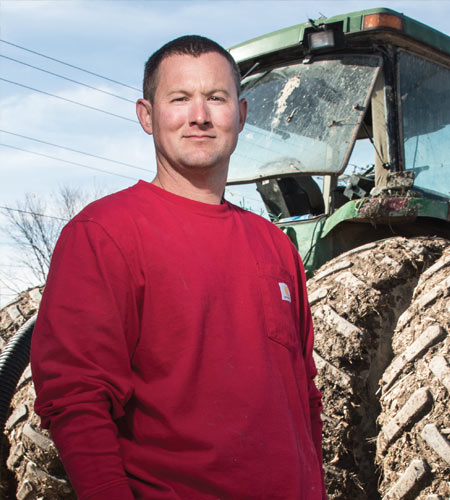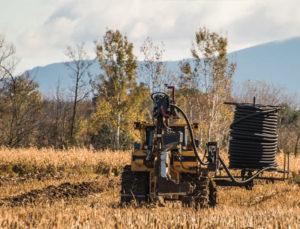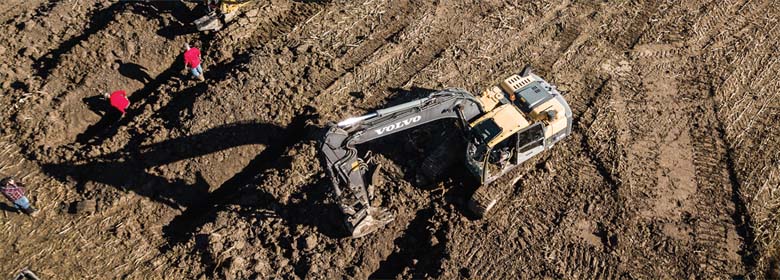The weather has always been a fickle, adversarial wild card for farmers, and as climate change makes extreme events more common and less predictable, the development of adaptive strategies has become ever more important. In the Northeast, recent years have seen an increase in flooding and persistent rain that leave fields saturated just as the planting season is getting underway.
Farmers with heavier soils and high clay content are particularly vulnerable to these adverse conditions. Many are turning to tile drainage as a solution for not only draining excess water from existing crop lands, but also for transforming previously unusable land into properly drained fields that are ready for planting.
It is by no means a recently developed practice. In the United States, tile drainage has been in the agricultural toolbox since the mid-1800s, when Scottish immigrant John Johnston employed a local potter to produce 3,000 clay pipes that he then installed on his farm in Geneva, New York. The result was an increase in his wheat yield from five bushels an acre to fifty bushels an acre.
A little farther east in New York State, the wealthy railroad industrialist and philanthropist William H. Miner also incorporated tile drainage as a successful strategy for his “Heart’s Delight” farm in Chazy. Between 1910 and 1920 he expanded the business to all areas of agricultural production and nearly five thousand acres, and upon his death his will established the William H. Miner Agricultural Research Institute, which is currently engaged in a number of studies related to tile drainage.
Over time, the technology has evolved, but the basic principle behind the need for drainage remains the same. A plant’s roots grow down through the soil but stop when they meet the water table. In the wet season, if the water table is high, the roots will be shallow and their ability to support the plant will be comprised. If the water table is lower, the roots shoot deeper into the soil and grow strong enough to sustain the plant during the dry, hot months of summer. As Jeff Carter explains, given this need to support the root system in a field, the importance of removing subsurface water becomes as vital as dealing with standing water.
Carter is an associate professor at the University of Vermont Extension Service who works with farmers around the state in developing best practices in soil and nutrient management for crop production, and he notes that the purpose of tile drainage is sometimes misunderstood.
“The general public might think we’ve drained out the field and it must be even drier,” he says. “But it doesn’t drain all the water out of the field. You can manage surface water with ditches, but tile drainage removes the water beneath the surface so that there is not a sustained water level near the soil surface. It just lowers the top of where the saturated soil is.”
Although farmers frequently install their own random tile lines to deal with isolated wet spots in their fields, a more comprehensive “systematic pattern tile drainage” installation is now available through commercial providers such as Redline Drainage. Based just a few miles from the Miner Institute in West Chazy, NY, Redline has been installing pattern tile drainage systems for over ten years, and a review of the process with owner Steve Roy provides some insights on how far the technology has advanced.
“We have a computer system that we map a field with,” says Roy.
 “By the time we’re done taking elevation shots we’ll have a couple thousand. That goes into a program that draws a topographical map, and from that I can decide which way the tiles need to run, or if there’s something in the way like ledge that we’ll need to jackhammer through. From there, we’ll take samples to see what’s in the soil. Heavier soil needs pipes that are closer together than lighter soils.”
“By the time we’re done taking elevation shots we’ll have a couple thousand. That goes into a program that draws a topographical map, and from that I can decide which way the tiles need to run, or if there’s something in the way like ledge that we’ll need to jackhammer through. From there, we’ll take samples to see what’s in the soil. Heavier soil needs pipes that are closer together than lighter soils.”
The pipes in use today are a far cry from the handmade clay models that John Johnston’s potter produced. “We have about the newest and fanciest gadgets we can get our hands on for the installation,” says Roy. The tile comes in large spools of four-inch corrugated plastic and there is a specialized tile drain plow for the installation. It’s a sophisticated operation with a significant price tag, and Roy can understand why some farmers would be wary of proceeding.
“The hardest field that a farm will tile will be their very first,” he says. “It’s just a large initial investment and a lot of people are afraid to take that first jump. Once they do, they don’t stop. We’ve got some customers that have tiled every year for five or six years in a row.”
Roy estimates the payback on the initial investment to be around four years on average. “Depending on how bad the land is. For some people it’s less. We’re on a job now and the gentleman thinks he’s going to pay off in two years.”
Redline is in close contact with the Miner Institute and public agencies to stay current and have input into the developing research and regulations around tile drainage. With water quality now a paramount issue for Lake Champlain and its tributaries, the Vermont Agency of Agriculture has established the multi-disciplinary Tile Drainage Advisory Group to examine how the practice might be impacting the amount of phosphorous going into rivers and streams that feed into the lake. Their recommendation was to release additional funding that would allow more data to be collected and analyzed before making any decisions.
Along with Roy, Jeff Carter is a participant in the advisory group, and through the UVM Extension Service he is centrally involved in the efforts to study and understand the impact and how to address it. He says the additional research is badly needed.
“There is not really conclusive evidence one way or the other,” he says. “There is not the data available in Vermont right now. Phosphorous concentrations are usually much lower in tile drained fields compared to overland flow, but some are concerned that although that might be true, the predominance has shifted from a soil particle attached to phosphorous to a dissolved phosphorous. But we’re not sure yet if that’s true.”
Carter’s team at UVM Extension is part of a study being funded by the Agency that is designed to start getting the answers needed to develop best practices for tile drainage.
 “It will include 40 different farms,” Carter says, “each one contributing information from at least one of their tile lines. It will be anonymous. It’s being conducted by my team here in Middlebury, with 10 sites drawn from the Champlain Valley Farmer Coalition members. In Franklin County there will be 10 sites, mostly associated with the Farmers Watershed Alliance, and another 20 sites conducted by several conservation districts spread around the state, so the effects on different types of soil can be seen.”
“It will include 40 different farms,” Carter says, “each one contributing information from at least one of their tile lines. It will be anonymous. It’s being conducted by my team here in Middlebury, with 10 sites drawn from the Champlain Valley Farmer Coalition members. In Franklin County there will be 10 sites, mostly associated with the Farmers Watershed Alliance, and another 20 sites conducted by several conservation districts spread around the state, so the effects on different types of soil can be seen.”
Steve Roy also feels the move towards additional research is the right one, and feels confident that the active participation of farmers is having a positive effect.
“Everybody’s being very proactive,” he says. “In the past two or three years, all farms have been very aggressive with improving water quality overall. I know the NCRS said this summer that they’ve shown phosphorous from farm runoff was coming down this year, and the new rules have not been in effect very long, so I thought that seemed like a pretty good turnaround time.”
The stakes are high for farmers who have invested in tile drainage and Carter understands the need to get as much data as possible, to minimize the phosphorous concentrations, and to acknowledge the economic and environmental benefits of tile drainage while addressing concerns about it.
“It does reduce soil erosion and compaction, gives more opportunity for cover crop management, manure management, and notill management. It reduces the risk of crop failure from weather conditions.”
He expresses optimism regarding the agency’s interaction with the agricultural and university research representatives on the Tile Drainage Advisory Group as well as the representatives from the Champlain Valley Farmer Coalition. “They know they are going to get some good, thoughtful comments. Through the whole RAP process and the tile drain process, the Agency does reach out to us, and we’re feeling really good about that.”

